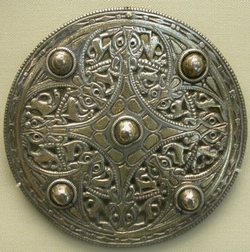Old English Poetry
Siân Echard, University of British Columbia

...I have always best enjoyed things in a foreign language, or one so remote as to feel like it (such as Anglo-Saxon). — J.R.R. Tolkien
Old English was one of Tolkien’s major professional preoccupations. His first position after World War I was on the staff of the Oxford English Dictionary, where his particular abilities in Germanic languages soon became useful as he toiled on entries for “w.” He later taught at Leeds, and then in 1925 he was elected to the Rawlinson and Bosworth Professorship of Anglo-Saxon at Oxford. One of his most famous scholarly contributions remains the lecture “Beowulf: The Monsters and the Critics.” You can read about his early adventures on the OED in Peter Gilliver, Jeremy Marshall and Edmund Weiner’s The Ring of Words: Tolkien and the Oxford English Dictionary (Oxford: Oxford University Press, 2006).
We will be reading examples of the heroic northern literature that contributed so much to some of the civilizations in The Lord of the Rings, including Beowulf, but this page is intended to point towards other aspects of Old English verse that Tolkien found appealing. His invented words and names often draw on Old English (Earendil, for example, is based on the OE earendel, ray of light), and he wrote alliterative verse himself. In addition, while aspects of the society of, for example, the Rohirrim clearly depend on the northern heroic tradition, the sense of sadness one often feels in The Lord of the Rings may suggest the elegiac traditions of both Old English and Middle Welsh (see also our course page for Medieval Welsh Poetry).
This page is not intended as a true introduction either to the language or the poetry; consult the Old English section of the course resources page for pointers to more complete and authoritative sources. In addition, there is a useful introduction to versification in John C. Pope, Seven Old English Poems. This page will simply highlight a few formal features of Old English verse, and point you to pages with original texts and translations for the poems we will be discussing in class.
Alliteration is important in Old English verse. Two verses — sometimes now called half-lines — are connected through a system of the repetition of initial consonants. Modern editions tend to print the two verses — the first half is called the on- verse, and the second the off-verse — in a single line, divided by extra space to indicate the caesura. Alliteration and stress work together in these lines. There are 3 main patterns of alliteration:
aa:ax; ax:ay; xa:ay
The syllables marked “a” constitute the principal alliteration. There can also be supplementary alliteration on the weaker syllables, yielding the following patterns:
ab:ab; ba:ab; aab:ab
Alliteration is not the only means of organizing the verses (half lines); patterns of stress are also important. The philologist Eduard Sievers (1850-1932) classified the rhythmic forms found in Beowulf into 5 types, and these are still used to discuss Old English verse. They are described by patterns of lift (stress) and drop. They are:
A: (the most common): lift, drop, lift, drop: ece Dryhten
B: (the first drop may have as many as 5 syllables) drop, lift, drop, lift: wæs thæt beorhte bold
C: drop, lift, lift, drop: Oft Scyld Scefing
D: lift, lift, half-lift, drop; or lift, lift, drop, half-lift: Frea ælmihtig
E: lift, half-lift, drop, lift: mann-cynnes Weard
These patterns have various subtypes, and there are many other complexities associated with Old English metrics not outlined here; if you would like to learn more, there is an excellent article on Meter as part of the E-Intro to Old English.
An important feature of Old English is its use of compounds. Sometimes these are combinations of two words in which one word modifies the other in some way, but often a compound may result from the combination of two words which mean more or less the same thing. These poetic compounds are useful to an alliterative poet who is often in the position of needing many different words to express the same thing, and compounds also help to fulfill the metrical requirements of Old English verse.
Kennings are a particular kind of compound (they can also be phrases) which refer to things metonymically or metaphorically; the use of “hwælweg” (whale-way) in The Seafarer to refer to the sea is an example. Alliterative verse often relies in part on formulae to fill out the lines, and some kennings did become formulaic — but poets could and did also invent their own compounds.
Formulaic phrases and clusters of elements sometimes referred to as formulaic themes can also characterize Old English poetry. In the elegiac poems we will be reading in class, the treatment of winter is a theme, as is the ubi sunt motif.
Go to a digital facsimile of Oxford, Bodleian Library MS Junius 111, the Cædmon Manuscript of Old English verse